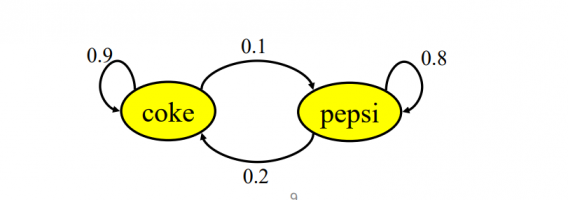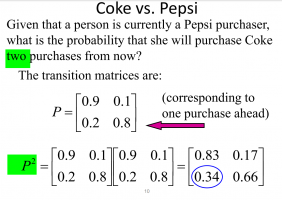shivajikobardan
Junior Member
- Joined
- Nov 1, 2021
- Messages
- 107
Design the markov model and transition matrix for the given data. Answer the following questions based on the mode.
a) If a person purchase coke now the probability of purchase of coke next time is 80%.
b) If a person purchases pepsi now the probability of purchasing pepsi next time is 70%.
Then,
Find the probability of using coke for a current pepsi user in 4th purchases-:
My solution-:

This is the transition diagram.
This is the transition probability matrix-:

So, what I did was basically to Took this TPM(Transition Probability Matrix) to the power 4. My basis for doing this was this source-: https://www.math.pku.edu.cn/teachers/xirb/Courses/biostatistics/Biostatistics2016/Lecture4.pdf
So what I got was-:

Now I am assuming that the rows means FROM and column side means TO. And the first element of row and column is "Coke". So, to find from Pepsi to Coke, I'd go to second row and first column, the value would be 0.5625
But the problem is that, I've conflicting source which claims the answer is sth else-:
It solves it like this-:
P=TPM
p=Current distribution=[0 1]
Now, for 2nd purchase
p²=p*P=[0.3 0.7]
For 3rd purchase-:
p³=p² * P
=[0.45 0.55]
For 4th purchase-:

=[0.525 0.475]
Thus, it concludes that the required answer is 0.525.
Which one is correct in your opinion?
a) If a person purchase coke now the probability of purchase of coke next time is 80%.
b) If a person purchases pepsi now the probability of purchasing pepsi next time is 70%.
Then,
Find the probability of using coke for a current pepsi user in 4th purchases-:
My solution-:
This is the transition diagram.
This is the transition probability matrix-:
So, what I did was basically to Took this TPM(Transition Probability Matrix) to the power 4. My basis for doing this was this source-: https://www.math.pku.edu.cn/teachers/xirb/Courses/biostatistics/Biostatistics2016/Lecture4.pdf
So what I got was-:
Now I am assuming that the rows means FROM and column side means TO. And the first element of row and column is "Coke". So, to find from Pepsi to Coke, I'd go to second row and first column, the value would be 0.5625
But the problem is that, I've conflicting source which claims the answer is sth else-:
It solves it like this-:
P=TPM
p=Current distribution=[0 1]
Now, for 2nd purchase
p²=p*P=[0.3 0.7]
For 3rd purchase-:
p³=p² * P
=[0.45 0.55]
For 4th purchase-:
=[0.525 0.475]
Thus, it concludes that the required answer is 0.525.
Which one is correct in your opinion?


